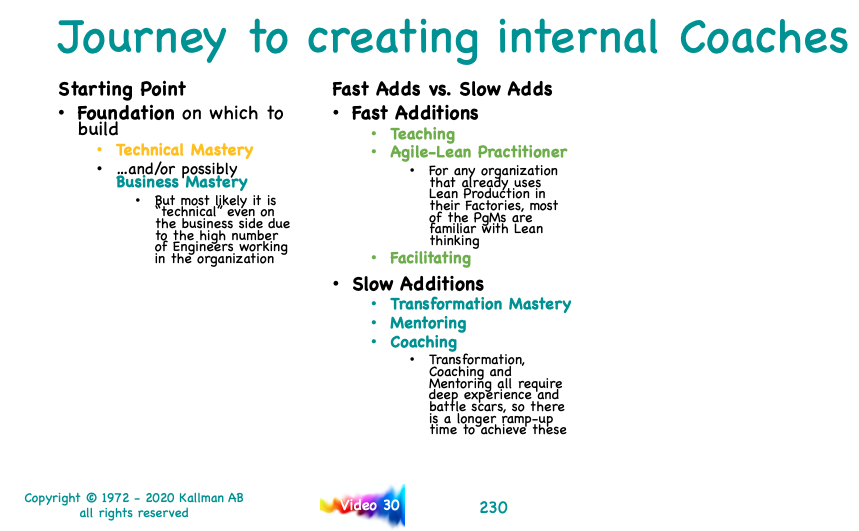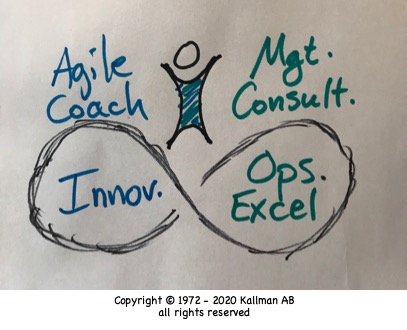Mastering the Transformation Basics is Simple, it’s just not Easy!
Back on 09 Sept 2020 … I got some really great feedback from Alistair Cockburn, so that is integrated that into this post … thanks Alistair!
Watching the leadership of organizations make the same mistakes, over-and-over again is, well, definitely not encouraging. One of the definitions of insanity is doing the same thing over-and-over again, yet expecting different results the next time around. And, although Einstein didn’t make that observation, the axiom is still true today.
One of the biggest “transformation” mistakes is when the leaders believe that they can “delegate” the transformation of the organization to the team level, thus (in their minds) avoiding the hard work that they must do in order to transform themselves, first. If the leadership is only talking-the-talk, and not walking-the-talk, then they quickly lose critical mass and credibility. And, they will waste their investments in what they believe to be “transformation.”
Leaders need to join their teams in the transformational journey.
Failure to do this simple step will result in not achieving the desired outcomes. Simple is not easy. It takes discipline and hard work to achieve the vision for the change.
Recently had a discussion with a colleague that is attempting to recruit a small army of Agile Coaches for an organization that wants to transform itself (this organization has recognized that if it doesn’t transform, then a failure to do that is an existential threat to its very survival).
Here are just a few of challenges when recruiting a small army of coaches:
- If we use the Agile Coaching Institute’s Coaching Competency Framework, then there are at least 23 combinations of the four areas & eight skills required to be a competent coach.
- If we add in Alistair Cockburn’s idea (borrowed from the martial arts) of Shu-Ha-Ri (essentially: beginners, competent, masters) to the 23 combinations that result from the Agile Coaching institute picture further down in this post, then this means that we have a very wide range of maturity levels (just under 70 combos) for the Agile Coaches that we need to synchronize and lead.
- Since each of the Coaches will have a wide range of skills, experience and leadership competencies, then that makes it very difficult for the individual tasked with leading a transformation – herding cats is the image that comes to my mind.
Here’s a picture of Alistair’s model (Shu-Ha-Ri with Kokoro – Kokoro can be roughly translated “just master the basics” -and- it can also be translated “heart”):

Here’s the picture for the Agile Coaching Competency Framework (courtesy of Dandy People and the Agile Coaching Institute). We should add Shu-Ha-Ri to all eight areas in this picture (to add another dimension for Agile Coaching maturity in each of the eight areas):

Getting a person up to a Ri-level in all eight areas above could take a lifetime to achieve (if it’s even possible to become “Ri” in all eight competences pictured above – which I don’t believe is actually possible – maybe seven of the eight is achievable since it will be a super rare combination of having someone at the Ri level in both Business Mastery and Technical Mastery). This takes time, dedication and discipline on everyone’s part to help the Coaches achieve “Ri.”
Applying Kokoro to the above picture would entail focusing on just a few basics for each of the eight Agile Coaching competence areas; and, eliminating everything else. Which is interesting since this aligns with the Agile Principle of:
“Simplicity–the art of maximizing the amount of work not done–is essential.”
Btw, a competent Agile Coach does everything a great Scrum Master does; plus almost everything else listed in the Agile Coach picture above. Many companies with which I have worked have mistakenly thought that Scrum Masters and Agile Coaches are the same thing. But, that simply is not the case, as can be seen by the skill sets in the image above.
Growing people into competent coaches takes a substantial commitment of time (some of these competencies take longer than the others to acquire):

The following image has some “Quick Wins” and “Longer Time Horizons” for an Agile Coach’s journey:

If you think you can bring someone up the Agile Coaching curve in six months, well … my experience has been that it takes time to build a great coach with the skills, values and battle scars needed to survive the politics and friction that are present in all organizations. This is a longer term investment and commitment to the journey your Agile Coaches are taking.
So, by combining Alistair’s picture with the Agile Coaching picture, it doesn’t take to much effort to realize that leveraging the outcomes delivered by a small army of Agile Coaches will quickly move (most likely the wrong direction) through the various levels of the Stacey Diagram or Cynefin Diagram (simple, complicated, complex and chaos) and the organization will end up with Chaos in many cases, rather than obtaining the expected outcomes.

The picture above becomes multi-dimensional by the time we add-in competencies and maturity levels as well. I have observed many times where a company believes it can hire a bunch of coaches, throw them together and voilà – we are now agile. Unfortunately, it doesn’t work that way. You need a really good, methodology-agnostic leadership framework around which you can rally your Organization’s Leaders, Agile Coaches, Scrum Masters, Product Owners and Teams.
Further, if the transformation is only focused on the team and individual levels (or worse, they’re trying to Scale Agile way too soon), then the odds for failure increases exponentially. It is incumbent upon the leadership to have a clear Vision for the transformational change they want to achieve (and communicate that 10 times more than they think they need to do).
Merely delegating the transformation down to the Program, team or individual levels simply doesn’t work. Organizations that try to do that will limp along (they may still be breathing, but they are probably already dead – they just don’t realize it yet).
Delegating transformation downward hasn’t worked in the past. It will not work in the future.
As Alistair points out, at the Kokoro level you return to the idea of “mastering the basics.”
- You return to the “simple.”
- You return to the “heart.”
- And, simple is NOT easy.
Management Consultants earn their very high consulting rates by taking the Chaotic, Complex and Complicated and then Distilling it down to the Simple. That, is the essence of being a true “Kokoro.”
And, this this ability to simplify also aligns with the Agile Principle of Simplicity (shared above). Executive, Enterprise Flow Trainers, Coaches & Mentors that also master the (Management Consulting) ability to simplify will add tremendous value to any organization with they work.

If you want to get to the heart of the matter and increase your odds of success, then let’s keep the conversation Flowing – let’s chat!
PS Here are the associated links to this blog post for:
#alistaircockburn #scrum #agile #pmi #pmp #culture#kanban#lean #flow #scaledagile #transformation #change #transform